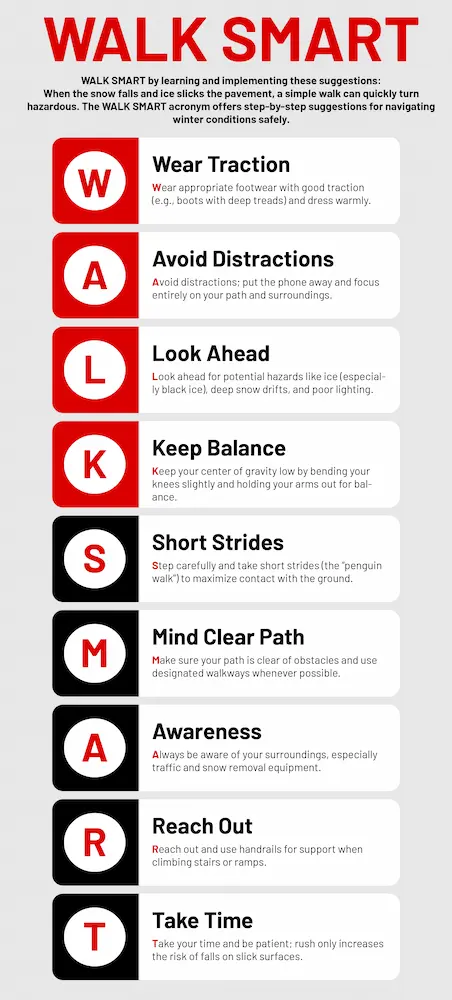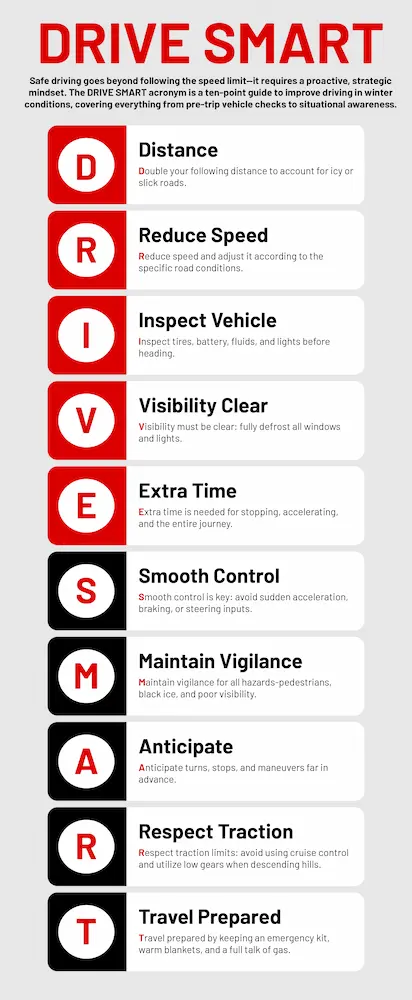Winter Safety Tips
The winter season brings a new set of challenges for students and staff, requiring vigilance both on foot and behind the wheel. Being prepared and actively knowing the risks are essential to staying safe. Nationally, the U.S. Bureau of Labor Statistics reports that a significant number of workplace nonfatal injuries still involve ice, sleet, and snow each year. With Utah often experiencing higher-than-average incident rates for weather-related mishaps, following safety guidelines like WALK SMART is critically important. Furthermore, winter hazards dramatically increase driving risks. The Utah Department of Public Safety (DPS) reports that winter sees the highest total number of traffic crashes compared to other seasons, and young adults remain a highly affected group. Southern Utah University is dedicated to helping our students and staff navigate this challenging season by promoting proactive safety measures to make winter travel as safe as possible.
WALK SMART by learning and implementing these suggestions: When the snow falls and ice slicks the pavement, a simple walk can quickly turn hazardous. The WALK SMART acronym offers step-by-step suggestions for navigating winter coniditions safely.
- Wear Traction
- Wear appropriate footwear with good traction (e.g., boots with deep treads) and dress warmly
- Avoid Distractions
- Avoid Distractions; put the phone away and focus entirely on your path and surroundings
- Look Ahead
- Look ahead for potential hazards like ice (especially black ice), deep snow drifts, and poor lighting
- Keep Balance
- Keep your center of gravity low by bending your knees slightly and holding your arms out for balance
- Short Strides
- Step carefully and take short strides (the "penguin walk") to maximize contact with the ground.
- Mind Clear Path
- Make sure your path is clear of obstacles and use designated walkways whenever possible
- Awareness
- Always be aware of your surroundings, especially traffic and snow removal equipment
- Reach Out
- Reach out and use handrails for support when climbing stairs or ramps.
- Take Time
- Take your time and be patient; rush only increases the risk of falls on slick surfaces.
Safe driving goes beyond following the speed limit-it requires a proactive, strategic mindset. The DRIVE SMART acronym is a ten-point guide to improve driving in winter conditions, covering everything from pre-trip vehicle checks to situational awareness.
- Distance
- Double your following distance to account for icy or slick roads.
- Reduce Speed
- Reduce speed and adjust it according to the specific road conditions.
- Inspect Vehicle
- Inspect tires, battery, fluids, and lights before heading.
- Visibility Clear
- Visibility must be clear: fully defrost all windows and lights
- Extra Time
- Extra time is needed for stopping, accelerating, and the entire journey
- Smooth Control
- Smooth control is key: avoid sudden acceleration, braking, or steering inputs.
- Maintain Vigilance
- Maintain vigilance for all hazards-pedestrians, black ice, and poor visibility
- Respect Traction
- Respect traction limits: avoid using cruise control and utilize low gears when descending hills.
- Travel Prepared
- Travel prepared by keeping an emergency kit, warm blankets, and a full tank of gas.
Severe Weather Notifications
SUU’s Campus Operations Team has created a scoring system to help assess weather conditions and guide campus responses to winter storms. Campus responses will fall into one of the following categories.

Text Version of Winter Conditions Chart
| Green: | Yellow: | Yellow: | Orange: | Red: |
|---|---|---|---|---|
| Continue Normal Operations | Delayed Start | Early Out | Full Day Remote | Snow Day |
| Campus is Open | Soft Campus Closure | Soft Campus Closure | Soft Campus Closure | Campus Closed Essential Functions Only |
| Outdoor Conditions are seasonably normal | Due to timing, severity, and/or duration of the storm - Expected to improve in the next 4 hours | Due to timing, severity, and/or duration of the storm - NOT Expected to improve in the next 4 hours | Due to timing, severity, and/or duration of the storm - Expected to improve in the next 12 hours | Due to timing, severity, and/or duration of the storm - Reduce campus activities to essential functions |
Some of the criteria SUU’s Campus Operations Team looks at when scoring a storm include:
- The severity and timing (arrival) of the weather event as issued by the National Weather Service
- Forecasted temperature (if expected to stay well below freezing)
- Latest information obtained from local law enforcement and street departments about road conditions (low visibility, icy roads, blowing snow, snowpack, etc.)
- SUU Facilities Management’s assessment includes: the ability to clear parking lots, walkways, ADA access, and stairways before the start of normal campus operations; tree damage or hazards; and expected visibility for clearing snow when students/staff/faculty are on campus
- Scheduled major events i.e. athletic events, concerts, tenant, and contractor operations
- Consultation with the Iron County School District, Southwest Tech, and the Iron County Emergency Manager
This scoring system is a predictive process in an effort to help the campus community be safe and provide a framework for better communication. However, all community members must come prepared to handle low temperatures, low visibility, and slick conditions even when SUU remains open for normal operations. This page includes tips on what to wear, how to plan ahead, and even what to do when traversing snow and ice to get to class or work.


 Wear Traction
Wear Traction
 Distance
Distance